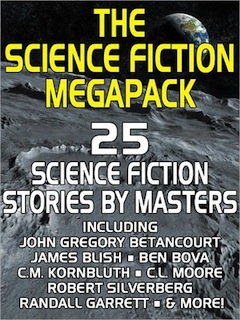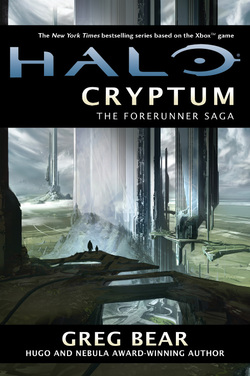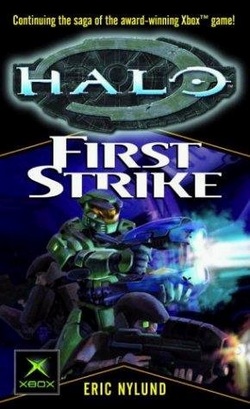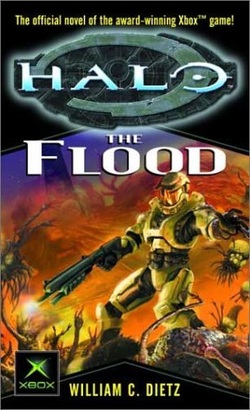 It took me a while to finally use this beautiful device I got from my wife and read "something" on it. Shame on me! It all happened during our September holiday to the Greek Island of Rhodes. Before we left I Amazoned and got me some non-fiction and this 69¢ bundle of SciFi short stories. To be honest, I didn't know what to expect of these little antiques. Most of them were written in the fifties and the sixties during the early days of the genre. The imagination of the writers was not hampered by scientific discoveries and as a result our solar system is still populated with many alien cultures. Where needed the laws of physics are bend by the authors to fit the craziest and imaginative stories. The threat of a nuclear disaster and communism is still present and this translates into interesting and fascinating tales. MegaPack is a great read if you don't mind the inaccuracies and the dated language and style. My personal favourites?
collected and published by Wildside Press LLC.  2 keer heb ik Jef Staes' boek gelezen. De eerste keer verslond ik het als een thriller; deze keer heb ik dit leesvoer wat beter gekauwd. Jef schrijft over innovatie en hoe je innovatie kan verankeren in je organisatie. Hij vertelt over het fenomeen van de rode aap, de Red Monkey® en hoe het beest gekoesterd wordt door de ene (de Breeder) en opgejaagd wordt door de andere (de Hunter). Zijn ideeën rond 2D- en 3D-organisaties en zijn analyse omtrent het menselijk gedrag in een organisatie (Settlers, Followers, Pioneers & Creators en de balans ertussen) is fascinerend. Ongetwijfeld ziet de oplettende lezer parallellen in zijn of haar organisatie. Vooral de conclusie rond de Engine of Innovation (Visioning, Casting, Learning, Investing) klinkt voor mij als een vanzelfsprekendheid; helaas zie ik ze zelden toegepast. Niettegenstaande Jef zich voornamelijk richt op innovatie en zijn hele betoog rond die kern opbouwt, ben ik van mening dat je een globale "search & replace" kan doen en het woord innovatie door verandering kan vervangen. Ik ben het volmondig eens met zijn idee rond de 3D-wereld waarin we vandaag leven, een wereld met voortdurende verandering waar ieder van ons zoveel te verwerken krijgt dat hij of zij het gevoel van permanent verdrinken krijgt. De oude methoden en waarden die we aangeleerd kregen werken niet meer, het wereldbeeld is veranderd en blijft veranderen. De controle zijn we kwijt, het tempo wordt te hoog. Onze 2D-wereld heeft er plots een 3de dimensie bijgekregen. Vanzelfsprekend is het boek een succes bij de changelings, mensen die verandering ademen; maar slaat het ook aan bij de 2D-generatie, de generatie die in deze "turbo" wereld meer en meer moeite heeft, het echte publiek voor dit boek? Het viel me pas op bij de tweede lezing dat Jef echt niet mals is voor de 2D-generatie. Kort door de bocht, hij beschouwt ze terminaal. Hij gelooft niet dat ze kunnen veranderen. Dat is hard, heel hard en ik vrees dat deze shock-therapie niet bij de 2D-manager zal aanslaan. Uit ervaring weet ik van niet. Ik ben ze al een paar keer tegengekomen, de primi inter pares, de rasechte 2D-managers, die ervan overtuigd zijn dat zij de problemen en uitdagingen moeten kunnen oplossen in plaats van een enabler te zijn. Shock therapie werkt niet, het leidt tot oeverloze discussies tussen 2 compleet incompatibele geesten die de dingen fundamenteel anders zien. Waar de 2D-manager al zijn energie steekt in het oplossen van het probleem, zoekt de 3D-manager naar zijn sterspelers; hoe groter kan het verschil in aanpak zijn? De zachte verandering daarentegen zie ik wel werken. Door stelselmatig aan te tonen dat het anders kan en daarbij zelfs betere resultaten te halen, zien 2D-managers een andere wereld opengaan. Maar leuk is het niet voor de 3D-manager, want hij wordt van alle kanten uitgedaagd en in de meeste gevallen zal hij meer tijd steken in het managen van de 2D-wereld dan in de verandering of innovatie zelf. Is Jefs boek dan een maat voor niks? Ik denk het niet, het laat ons nadenken over de manier waarop we bezig zijn en toont een andere aanpak, een wijze die de 3D-wereld veel beter aankan. Of de lezer daarvoor openstaat, is maar de vraag. Zelf probeer ik altijd mijn teams samen te stellen met mensen die het team sterker maken door hun kennis en ervaring, het is verrassend hoe zo'n team het niveau en haar mogelijkheden bijna exponentieel doet toenemen. Als manager is het echter niet altijd gemakkelijk, omdat je weet en beseft dat jij zeker de primus inter pares niet bent en toch moet je de energie in je team kunnen kanaliseren en richten naar een gemeenschappelijk doel. Op zijn minst een uitdaging! Mijn organisatie is een oerwoud door Jef Staes ISBN 9-789020-971866  My fourth novel this year. I'm catching up. It will also be the last Halo book for a while. Halo Cryptum is part one of the Forerunner trilogy, a promising prequel to the Halo universe. Bear creates a universe where humans and Forerunners co-existed and fought each other. The human race bumped into the Forerunners as they were reaching out, fleeing the Flood. The conflict ended badly for the human race as it was reduced to a segregated and primitive state by the Forerunners. We learn this story through the eyes and ears of Bornstellar, a young forerunner, a Manipular, who is restlessly driven to Erde-Tyrenne where he opens the Cryptum of the Didact a member of the Promethean Warrior class. Gradually the manipulations of the Librarian are revealed, a Lifeshaper and wife of the Didact who tries to stop the threat of the Flood and the answer the Builder class created: the Halo installation. Bear tells us the story of the the Forerunners, a caste based society, who are ruled by the Mantle, a belief system which tasks them with the plight to protect and promote life. As a result the Forerunners believe to be above other races, even to such an extent that they will stop others to rise on their own merits. Will this Forerunner Order withstand the Floods Chaos? Halo: Cryptum written by Greg Bear ISBN 9-780330-545624 Find it on Amazon.com - Find it on Amazon.co.uk  First Strike flashes back and forth on the timeline of the first two books to launch itself into an exciting third part. It picks up the story with the remaining Spartans on Reach who try to survive the relentless Covenant attacks whilst digging themselves deeper and deeper into Reach until they finally bump into doctor Halsey. It flash-forwards to the Master Chief after the destruction of Halo and tells us how he gets back to Reach with a small number of survivors onboard a captured Covenant flagship. Reach wasn't completely glassed as the Covenant were still looking for something hidden under the surface of the planet. Forerunner artifacts to be precise. On Reach, Master Chief Spartan-117 aka John sets out to find the remainder of his team and after re-uniting with doctor Halsey and the remaining Spartans and rescuing Admiral Whitcomb they secure the artifact. When they learn that the position of Earth has been compromised a daring plan is executed to stop the Covenant en route. The great thing about Nylunds books is that he goes much further than the story arc of the games. He fills in the gaps, expands the Halo universe and tells us thrilling stories whilst giving a face and a voice to both the united earth forces and their foes, the Covenant. written by Eric Nylund ISBN 9-781841-494227 Find it on Amazon.com - Find it on Amazon.co.uk  The book of the award-winning game. And unfortunately in this case it's a bit too literally. I had finished the game (the Anniversary Edition) just recently and it's awkward to read what you did in the game retold step by step. Even the scenery is described exactly as in the game in many cases to an absurd degree. Yes, Dietz did give the Covenant soldiers names and voices. He let them play some minor parts as he did with the remaining ODST Helljumpers and the crew of the Pillar of Autumn. But it's nothing but scratching the surface to tell the story from three different points of view: Master Chief; the Covenant and the crew of the Pillar of Autumn. After having read the Fall of Reach, this episode was a bit disappointing. Surely it allows non-gamers to experience the story, but gamers could as well replay the game on a higher difficulty and get a lot more satisfaction. The book plays on safe and it feels as if Dietz was kept on a leash when he was commissioned to write the book. In fact he wasn't, he did exactly what he was supposed to do. Halo: the Flood written by William C. Dietz ISBN 978-1-84149-421-0 Find it on Amazon.com - Find it on Amazon.co.uk |
AboutJanuary 2012. I solemnly promise myself to read at least one book per month. It doesn't really matter what, as long as I r.e.a.d! Archives
October 2012
Categories
All
|
 RSS Feed
RSS Feed
